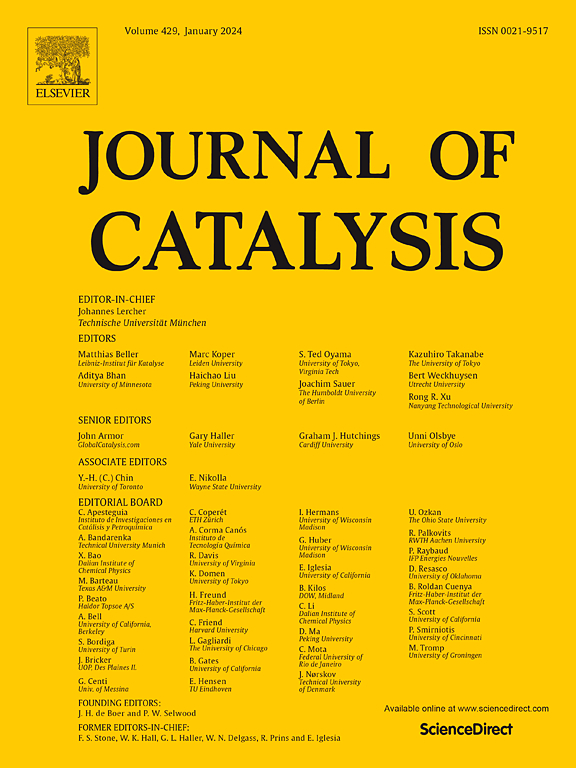卤化物双钙钛矿Cs2NaBiX6 (X = Cl/Br/I)光催化CO2还原的机理
IF 6.5
1区 化学
Q2 CHEMISTRY, PHYSICAL
引用次数: 0
摘要
金属卤化物双钙钛矿由于其可调的带隙、丰富的活化位点和良好的光催化性能,近年来在光电子学、钙钛矿太阳能电池和人工光催化方面的潜在应用受到了极大的关注。本文采用第一性原理计算方法研究了Cs2NaBiX6 (X = Cl/Br/I)(100)和(110)表面上质子辅助电子转移CO2光还原反应机理,以阐明Cs2NaBiX6催化剂的光催化活性。Cs2NaBiX6钙钛矿的能带能级与CO2还原产物(如HCOOH、HCOH、CO和CH4)的氧化还原电位之间存在很强的相关性,这表明了它们作为高效光催化剂的潜力。完整的还原途径表明,这些双钙钛矿具有丰富的活性吸附位点,CO2在Bi、Na、X和Cs位点上成功还原。值得注意的是,Bi位点在两个表面上都是最有效的激活中心,因为它们在还原途径上的速率决定步骤中表现出最低的能垒。在质子辅助的双电子转移过程中,CO2可以还原为CO和HCOOH。然而,由于HCOOH*→HCOOH解吸步骤的吸热性质,HCOOH更有可能进一步还原为CH3OH或CH4,而不是作为单一产物释放。CH4的形成在热力学上都是有利的,但只能从(110)表面解吸,而在(100)表面仍然被强烈吸附。具有最低能垒的计算路径表明(110)表面比(100)表面表现出更好的催化活性。有趣的是,Cs2NaBiX6钙钛矿在光催化还原CO和CH4的关键中间体之间表现出明显的结垢关系。在研究的体系中,Cs2NaBiBr6表现出最高的CO2还原活性和选择性,其活化势垒为0.67 eV,优于Cs2NaBiI6(0.74 eV)和Cs2NaBiCl6(0.99 eV)。这些发现为双钙钛矿光催化剂的合理设计提供了重要的见解,并突出了它们在可持续能源应用方面的潜力。本文章由计算机程序翻译,如有差异,请以英文原文为准。

Mechanistic pathways in the photocatalytic CO2 reduction on halide double perovskite Cs2NaBiX6 (X = Cl/Br/I)
Metal halide double perovskites have recently gained significant attention for their potential applications in optoelectronics, perovskite solar cells, and artificial photocatalysis owing to their tunable bandgaps, abundant activation sites, and favorable photocatalytic properties. Herein, the proton-assisted electron transfer CO2 photoreduction reaction mechanism on Cs2NaBiX6 (X = Cl/Br/I) (100) and (110) surfaces with the aim to elucidate the photocatalytic activity of Cs2NaBiX6 catalysts is investigated by using first-principles calculations. The Cs2NaBiX6 perovskites demonstrate a strong correlation between their band energy levels and the redox potentials of CO2 reduction products (e.g., HCOOH, HCOH, CO, and CH4), underscoring their potential as efficient photocatalysts. Complete reduction pathways reveal that these double perovskites possess abundant active adsorption sites, with CO2 reduction occurring successfully on Bi, Na, X and Cs sites. Notably, Bi sites emerge as the most effective activation centers on both surfaces, as they exhibit the lowest energy barriers for the rate-determining steps across the reduction pathway. For the proton-assisted two electron transfer process, CO2 can be reduced to CO and HCOOH. However, HCOOH is more likely to undergo further reduction to CH3OH or CH4, rather than being released as a single product, due to the endothermic nature of the HCOOH* → HCOOH desorption step. CH4 formation is thermodynamically favorable on both surfaces, but can only desorb from the (110) surface, while it remains strongly adsorbed on the (100) surface. The calculated pathways with the lowest energy barriers indicate that the (110) surfaces exhibit superior catalytic activity compared to the (100) surfaces. Intriguingly, the Cs2NaBiX6 perovskites display distinct scaling relations between key intermediates for the photocatalytic reduction to CO and CH4. Among the studied systems, Cs2NaBiBr6 demonstrates the highest activity and selectivity for CO2 reduction, with an activation barrier of 0.67 eV, outperforming Cs2NaBiI6 (0.74 eV) and Cs2NaBiCl6 (0.99 eV). These findings provide critical insights into the rational design of double perovskite photocatalysts for CO2 reduction and highlight their potential for sustainable energy applications.
求助全文
通过发布文献求助,成功后即可免费获取论文全文。
去求助
来源期刊

Journal of Catalysis
工程技术-工程:化工
CiteScore
12.30
自引率
5.50%
发文量
447
审稿时长
31 days
期刊介绍:
The Journal of Catalysis publishes scholarly articles on both heterogeneous and homogeneous catalysis, covering a wide range of chemical transformations. These include various types of catalysis, such as those mediated by photons, plasmons, and electrons. The focus of the studies is to understand the relationship between catalytic function and the underlying chemical properties of surfaces and metal complexes.
The articles in the journal offer innovative concepts and explore the synthesis and kinetics of inorganic solids and homogeneous complexes. Furthermore, they discuss spectroscopic techniques for characterizing catalysts, investigate the interaction of probes and reacting species with catalysts, and employ theoretical methods.
The research presented in the journal should have direct relevance to the field of catalytic processes, addressing either fundamental aspects or applications of catalysis.
 求助内容:
求助内容: 应助结果提醒方式:
应助结果提醒方式:


